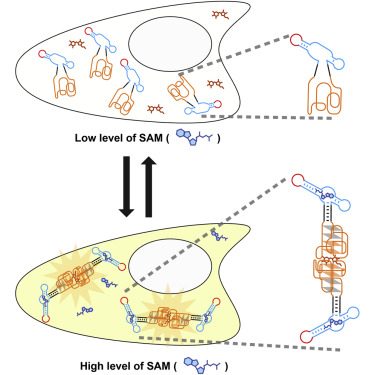当前位置:
X-MOL 学术
›
Cell Chem. Bio.
›
论文详情
Our official English website, www.x-mol.net, welcomes your feedback! (Note: you will need to create a separate account there.)
A Fluorogenic RNA-Based Sensor Activated by Metabolite-Induced RNA Dimerization.
Cell Chemical Biology ( IF 8.6 ) Pub Date : 2019-10-17 , DOI: 10.1016/j.chembiol.2019.09.013 Hyaeyeong Kim 1 , Samie R Jaffrey 1
Cell Chemical Biology ( IF 8.6 ) Pub Date : 2019-10-17 , DOI: 10.1016/j.chembiol.2019.09.013 Hyaeyeong Kim 1 , Samie R Jaffrey 1
Affiliation

|
Corn is a fluorogenic RNA aptamer that forms a high-affinity quasi-symmetric homodimer. The Corn dimer interface binds DFHO, resulting in highly photostable yellow fluorescence. Because of its photostability, Corn would be useful in RNA-based small-molecule biosensors, where quantitative accuracy would be affected by photobleaching. Here we describe a strategy for converting the constitutive Corn dimer into a small-molecule-regulated fluorescent biosensor that detects S-adenosylmethionine (SAM) in vitro and in living cells. We fused the Corn aptamer into a helical stem that was engineered by circularly permuting the SAM aptamer from the SAM-III riboswitch. In the absence of SAM, the Corn portion of this fusion RNA is unable to dimerize. However, upon binding SAM, the RNA dimerizes and binds DFHO. This RNA-based biosensor enables detection of SAM dynamics in living mammalian cells. Together, these data describe a class of RNA-based biosensor based on small-molecule-regulated dimerization of Corn.
中文翻译:

基于代谢物诱导的RNA二聚化活化的基于荧光RNA的传感器。
玉米是形成高亲和力的准对称同型二聚体的荧光RNA适体。玉米二聚体界面与DFHO结合,产生高度光稳定的黄色荧光。由于其光稳定性,玉米将可用于基于RNA的小分子生物传感器,该传感器的定量准确性会受到光漂白的影响。在这里,我们描述了将本构玉米二聚体转化为可在体外和活细胞中检测S-腺苷甲硫氨酸(SAM)的小分子调节型荧光生物传感器的策略。我们将玉米适体融合到一个螺旋茎中,该螺旋茎是通过从SAM-III核糖开关中循环排列SAM适体而设计的。在没有SAM的情况下,该融合RNA的玉米部分不能二聚。但是,结合SAM后,RNA会二聚并结合DFHO。这种基于RNA的生物传感器能够检测哺乳动物活细胞中的SAM动态。这些数据一起描述了基于小分子调节的玉米二聚化的一类基于RNA的生物传感器。
更新日期:2019-11-09
中文翻译:

基于代谢物诱导的RNA二聚化活化的基于荧光RNA的传感器。
玉米是形成高亲和力的准对称同型二聚体的荧光RNA适体。玉米二聚体界面与DFHO结合,产生高度光稳定的黄色荧光。由于其光稳定性,玉米将可用于基于RNA的小分子生物传感器,该传感器的定量准确性会受到光漂白的影响。在这里,我们描述了将本构玉米二聚体转化为可在体外和活细胞中检测S-腺苷甲硫氨酸(SAM)的小分子调节型荧光生物传感器的策略。我们将玉米适体融合到一个螺旋茎中,该螺旋茎是通过从SAM-III核糖开关中循环排列SAM适体而设计的。在没有SAM的情况下,该融合RNA的玉米部分不能二聚。但是,结合SAM后,RNA会二聚并结合DFHO。这种基于RNA的生物传感器能够检测哺乳动物活细胞中的SAM动态。这些数据一起描述了基于小分子调节的玉米二聚化的一类基于RNA的生物传感器。

























 京公网安备 11010802027423号
京公网安备 11010802027423号